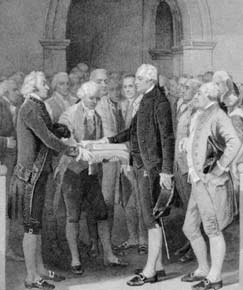 By 1796, George Washington had created a solid government for the new Republic. But he was tired; the political wrangling taken its toll on him. Had he wanted a third term, there is no doubt he would’ve been reelected, but he longed to return to Mount Vernon to live out his years as a farmer.
By 1796, George Washington had created a solid government for the new Republic. But he was tired; the political wrangling taken its toll on him. Had he wanted a third term, there is no doubt he would’ve been reelected, but he longed to return to Mount Vernon to live out his years as a farmer.
Washington was sixty-four years old when he decided to end his political life. Besides, he was committed to a government where power changed hands frequently and peacefully, so he did not want to continue in office too long. This peaceful transfer of power may well have been his greatest achievement. And we see it repeated every four years when we elect, then inaugurate, a new president.
At the time, America was the first nation in modern history to try an election-based form of democratic government, known as a constitutional republic. The rules by which the government operated were set up in the Constitution, and the people elected their representatives. By stepping down after two terms, Washington proved that a person of character can avoid being corrupted by power.
By this time, Washington had achieved his major goals. He had helped create a united nation that would endure. He has successfully established the role of the federal government. He brought peace to the frontier, kept American out of European wars, and had established the nation’s capital. As he hoped, the nation was growing into a union rather than a coalition of separate states. Therefore, he decided not to run for reelection in 1796. His decision set another precedent – that presidents should serve no more than two terms, only broken by FDR during World War II.
As one of his last public acts, in late 1796, Washington delivered a farewell address Congress. In it, he urged all Americans to remain devoted to the American union. He also counseled them to avoid political parties and “permanent alliances” with “any portion of the foreign world.” He believed that foreign alliances would tie the hands of the nation and prevent the government from acting in its own best interest.
The election of 1796 would provide the next great test for this great experiment called the United States of America. The Jeffersonians obviously favored Thomas Jefferson to succeed Washington is president. The Federalists favored John Adams, Washington’s vice president for the last eight years. Alexander Hamilton, however, did not like Adams. So he secretly worked against Adams on behalf of another man, without success. When the Electoral College votes were tallied, Adams had seventy-one, Jefferson had sixty-eight, and Hamilton’s candidate only had 59. At that time, the Constitution stated that the candidate with the most votes would become the President and the one the second most votes will become Vice-President. As results Adam thus became President and Jefferson Vice-President, even though they were from opposite political parties.
On Inauguration Day, March 4, 1797, Washington, Adams, and Jefferson entered Congress Hall in Philadelphia – then the nation’s capital. There, John Adams took the oath of office as the new president of the United States. Afterward, as they got ready to leave, Adams stepped aside at the door to allow Washington to go through first. But Washington was well aware of the historic significance of the moment. He stopped and asked Adams to leave first. After all, he said, Adams was now president of the United States, and Washington was now just a private citizen. Adams led, followed by Jefferson, and Washington went last.
This was the first time in human political history that power was transferred between two common citizens without the death or violent overthrow of the person losing power. The Constitution had passed its first crucial test primarily because of George Washington’s commitment to it into the spirit of the American Revolution.
©2012 Off the Grid News